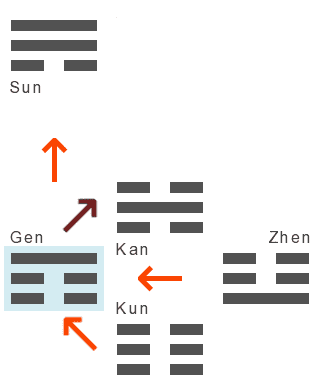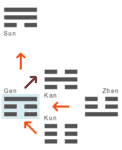What does Gen stand for?
To become still. To allow things to happen. To let go. All of that is Gen. To feel oneself. Just take a moment to truly feel. To sense. To actually perceive the situation. To perceive everything. And then: Rethink things. Completely anew. Come up with a completely new solution with… a beginner’s mind.
Usually, we go through our daily routines without much thought. We wake up, brush our teeth, get dressed. Breakfast and off to work. We neither notice the toothbrush nor the breakfast sandwich, and we only truly wake up when we are sitting at our desks reading emails. At some point, we developed this routine, it worked, and since then, we have been going through the motions. If something unexpected happens, an exceptional situation, we might notice what we are doing. Because something does not work. And then, we might begin to examine elements of our routine and question whether the standard solution is still effective. Because perhaps the problem to be solved has changed in the meantime. Or the problem is the same, but there are now better possibilities…
The Einstellung Effect: Negative Consequence of Mechanized Thinking
The Einstellung effect, a phenomenon in which the mind operates in a mechanized state, automatically applying a previously developed standard solution without thoroughly examining the current problem, has been recognized in scientific circles (Wikipedia). It is considered a negative consequence of past experiences in problem-solving. The fact that a solution was successful in the past tempts individuals to apply that solution again and again. This obscures the view of the problem itself, the problem in the here and now, the new problem that often only superficially resembles the old one. Consequently, the standard solution fails to truly address the situation.
In fact, we have the opportunity to assess the effectiveness of our problem-solving routines on any given day, even in the absence of exceptional circumstances. However, fate sometimes graciously presents us with these extraordinary situations. It is during such moments that we embark on a process of decluttering and discarding waste. Not only in the material realm, but also shedding useless emotions, thoughts… And, of course, standard answers and standard solutions.
Seeing the World Anew with a Beginner’s Mind
Ultimately, this process leads us to a state of complete emptiness. And suddenly we rediscover something profound: the beginner’s mind. Known as Shoshin in Zen Buddhism, it embodies an attitude of being a beginner: open, enthusiastic, without prejudice or preconceived notions.
Gen is associated with the functional circuits of the Large Intestine (LI) in the classics of Traditional Chinese Medicine (see King Wen’s Later Heaven). Corresponding references can be found here: Phase Element Metal: Large Intestine.
Following the Path of the Dao: What Is?
In the model of Following the Path of the Dao, Gen belongs to the dynamic landmark points. In Gen, the dynamics arise from a strong Yang line following receptive Yin (two Yin lines in Zhen or three Yin lines in Kun): a positive vibration that generates momentum.
Questions for self-exploration may include:
- What do I feel when I allow myself to become still? How do I feel?
- And as I expand the radius of my attention now, expanding it further around me: What is there? What do I perceive?
- And if I had the eyes of a beginner? Or if I were to look through the eyes of a stranger? What would this stranger see when looking at my familiar life?
- What would he/she say about it? Say to me?
- And what do the things, my belongings, tell me when I listen to them? What do they reveal to me? And what do they reveal about me?
Where does Gen emerge from?

Within a hexagram Gen emerges either from Zhen or Kun (exception: the hexagram begins with Gen / Gen is the lower trigram). The red arrows indicate that a (solid) yang line is added to each previous trigram. Yang symbolizes energy, activity. Any clear disengagement gives us tangible results: deep transformation and reorientation.
Gen emerges from Kun, the Earth
Kun, the earth, stands for a thorough inventory. We may note things that are unnecessary ballast, which obstruct our efforts and deplete our energy. When Gen arises from Kun, we can confidently let go of the ballast and surrender ourselves to the force of earth’s gravity. In doing so, we not only release our muscles and tendons but our entire being.
Examples of hexagrams where Gen emerges from Kun → here.
Gen emerges from Zhen, the Thunder
From the initial decision (Zhen, the thunder), letting go and dissolution (Gen) arise: the old is transformed. This transformation can occur abruptly, but often happens gradually and smoothly. Initially, the old structure continues to exist, slowly dissolving over time, while the new structure is already growing and integrating the old.
Examples of hexagrams where Gen emerges from Zhen → here.
What does Gen develop into?

Within a hexagram Gen develops either into Sun or Kan (exception: the hexagram ends with Gen / Gen is the upper trigram).
Gen develops into Kan, the Water
Kan, the water, develops when a (broken) yin line is added (indicated by the dark arrow; yin symbolizes receptivity). Gen‘s disengagement opened a pathway for us to reconnect with our spiritual self: our own inner, intuitive wisdom, accumulated throughout our journey leading up to this moment, ready to nurture us.
Examples of hexagrams where Gen develops into Kan → here.
Gen develops into Sun, the Wind / Tree
Sun, the wind / tree, is develops by adding a solid yang line at the top (indicated by a red arrow; yang symbolizes energy, activity). Through letting go (Gen), we free ourselves from unnecessary burdens and can concentrate our forces. We then stretch the bowstring until finally our arrow, Sun, shoots forth with vigor: unstoppable, relentless, heading towards the target.
Examples of hexagrams where Gen develops into Sun → here.
Reference
Phase Element: Metal
Functional Circuit: Large Intestine (LI)
Modern Interpretation
Disengagement; transformation; harmonization
Traditional Interpretation
To hold still, to persevere; a meditative state
Direction: downwards
Interpretation: to enwomb, to keep under control; good framework (eventually perceived as constraining); completion towards the outside; delimitation, self-protection



